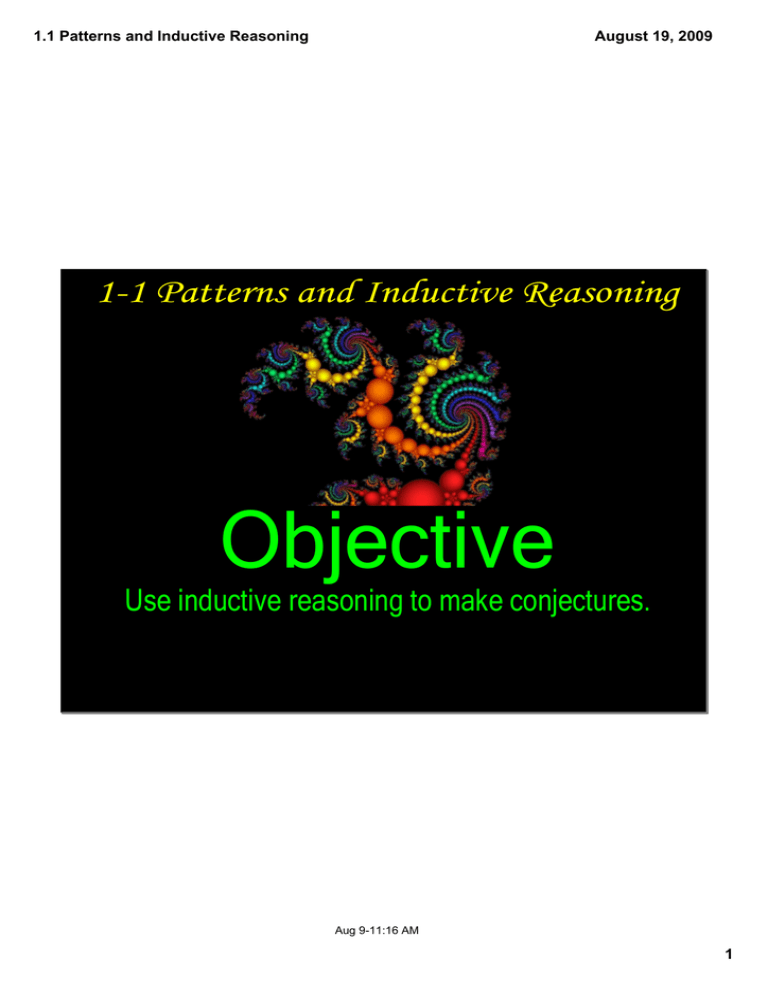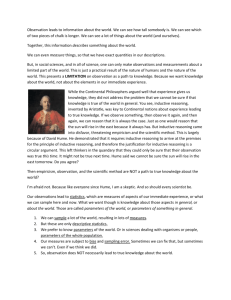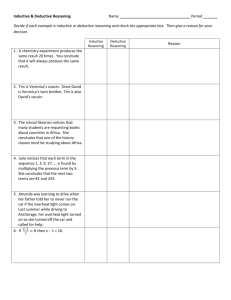Objective 11 Patterns and Inductive Reasoning Use inductive reasoning to make conjectures. 1.1 Patterns and Inductive Reasoning
advertisement

1.1 Patterns and Inductive Reasoning August 19, 2009 1­1 Patterns and Inductive Reasoning Objective Use inductive reasoning to make conjectures. Aug 9­11:16 AM 1 1.1 Patterns and Inductive Reasoning August 19, 2009 Aug 15­3:42 PM 2 1.1 Patterns and Inductive Reasoning August 19, 2009 Which do you think describes the square of any odd number? It is odd. Correct Incorrect HOW DO YOU KNOW? Aug 9­11:30 AM 3 1.1 Patterns and Inductive Reasoning August 19, 2009 Reasoning based on patterns that you observe is called INDUCTIVE REASONING. Find a pattern for this sequence. Find the next two terms in the sequence. 3 6 12 24... 48 96 Aug 9­11:38 AM 4 1.1 Patterns and Inductive Reasoning August 19, 2009 A conclusion you reach using inductive reasoning is called a CONJECTURE. Make a conjecture about the sum of the first 30 odd numbers. Step 1: Find the first few sums. Step 3: Make a conclusion. 1 = 1 + 3 = 1 + 3 + 5 = 1 + 3 + 5 + 7 = The sum of the first 30 odd numbers is 302 or 900. Step 2: Find a pattern. 1 = 1 = 12 1 + 3 = 4 = 22 1 + 3 + 5 = 9 = 32 1 + 3 + 5 + 7 = 16 = 42 Aug 9­11:50 AM 5 1.1 Patterns and Inductive Reasoning August 19, 2009 Not all conjectures turn out to be true! You can prove that a conjecture is false by finding one COUNTEREXAMPLE. Aug 9­12:05 PM 6 1.1 Patterns and Inductive Reasoning August 19, 2009 Find a counterexample that makes these conjectures false: The square of any number is greater than the original number. Any number and its absolute value are opposites. Aug 9­12:13 PM 7 1.1 Patterns and Inductive Reasoning August 19, 2009 HOMEWORK p. 6 # 1­6, 17­18, 19­22, 25­26, 51, 52 CHALLENGE #54 Aug 9­12:27 PM 8





